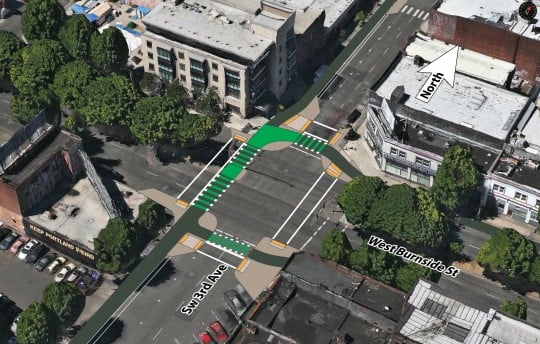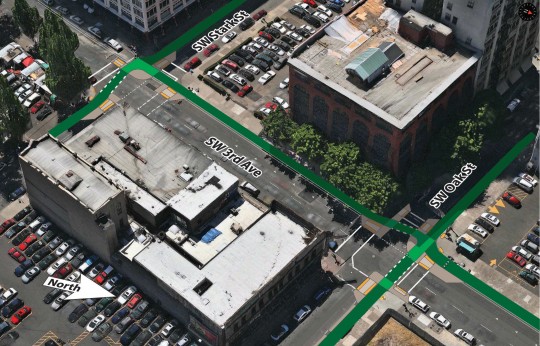The local street planner who created the “protected intersection” concept has come up with six sketches of where it could be done in Portland.
The catch is that in many cases, the city would have to re-allocate road space away from auto parking and standard travel lanes.
The design uses a few relatively simple changes, inspired by Dutch design — a “median refuge island,” a “forward stop bar” and so on — to slightly rearrange traffic flow in a way that greatly increases biking and walking visibility, comfort and safety.
Nick Falbo, who works as a senior planner for Alta Planning and Design but did this project as a volunteer on his own time, said he got the idea to create them after he gave a presentation about protected intersections at a conference last fall. A city employee who was attending, he said, asked where in Portland protected intersections could go.
“I’m thinking, like, where can’t they go?” he said.
The catch is that in many cases, the city would have to re-allocate road space away from auto parking and standard travel lanes to create the protected intersection and accompanying protected bike lane. In the example above, the city would remove a handful of parking spaces along the north side of Burnside (not exactly a thriving business strip at the moment) in order to create a vastly improved connection for people coming across the Burnside Bridge and turning left onto the new 3rd Avenue bike lane.
But tradeoffs wouldn’t be needed everywhere.
Above is an example of three streets where no traffic tradeoffs are needed at all: the newly important bike intersections at Southwest 3rd, Stark and Oak downtown. On all three streets, Falbo suggests switching the position of the parking and bike lanes to put bike lanes along the curb. Presumably this would require removing a parking space or two to keep open lines of sight at parking lot entrances, but that’s doable.
Today, all of these streets have wide buffered bike lanes. Why don’t they already have parking-protected lanes? On 3rd Avenue, it’s not clear. But on Stark and Oak, the reason was that the Portland Fire Department said it needed both lanes of traffic in case a ladder needed to reach one of the buildings there. If parking spaces ran down the middle of the street, they might not have a place to position the side braces of their ladder truck.
Falbo questions whether that’s really a problem, pointing out that if necessary, a single mid-block parking space could be kept clear for that purpose.
Moving west through downtown, here’s where Stark meets Broadway. This would let the flow of bike traffic south from the Broadway Bridge and Northwest Portland make a simple two-stage turn onto Stark rather than merging left three times across Broadway. It’d require removing one of Broadway’s three auto travel lanes.
On the west edge of downtown, here’s the ugly cluster of streets where Alder meets Burnside at 19th. Here Falbo envisions two useful bike connections meeting up: Northwest 19th, which has a southbound bike lane just north of Burnside and would lose a dedicated right-turn lane; and Alder Street, which would lose a general travel lane and get a 10-foot-wide bidirectional parking-protected bike lane. As we reported last week the City is already looking at this location for potential bike access improvements, but so far they haven’t released any details.
Advertisement
Falbo said he’s got mixed feelings about bidirectional protected bike lanes, especially relatively narrow ones on a hill, as this one would be. But he said this might be worthwhile because Alder provides such a natural and intuitive connection to the Morrison Bridge — a perfect link between the fast-growing residential area of Northwest Portland and the fast-growing job center of the Central Eastside.
Speaking of the Central Eastside, here’s Falbo’s attempt to correct two of Portland’s biggest biking failures of the last decade: not installing a north-south bike lane on Grand along with the east-side streetcar line, and not building an east-west protected bike lane on Burnside when that street was rebuilt in 2009.
Here, Falbo suggests a left-side northbound parking-protected bike lane on Grand, replacing one of the street’s four general travel lanes.
Burnside would also get an eastbound protected bike lane and lose one of its three eastbound travel lanes. This would still leave potential conflicts with the many buses that run east on Burnside — they’d presumably have to stop in one of the two travel lanes and unload onto a new “floating” bus platform.
Finally, here’s a world-class bike facility concept on what Falbo describes as maybe the most challenging street in Portland for a new protected bike lane: inner Southeast Hawthorne, with its huge volumes of bikes, buses and cars.
On 7th Avenue south of Hawthorne, Falbo imagines removing a left-turn lane in order to make room for better bike lanes. North, he’s got a center turn lane but no street parking on the east side.
Whatever the case, a protected intersection would create a smooth, intuitive two-stage turn for people biking east from downtown and turning north up 7th, or south on 7th to turn east on Hawthorne.
“Once you’ve figured it out here, you can figure it out anywhere in the city,” Falbo said.
— Michael Andersen, (503) 333-7824 – michael@bikeportland.org
BikePortland can’t survive without paid subscribers. Please sign up today.








